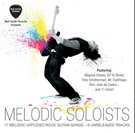Practicing One Thing Is Practicing Everything
 When we really understand how to practice guitar, we realize that practicing one thing affects everything else we play, for good or for bad!
When we really understand how to practice guitar, we realize that practicing one thing affects everything else we play, for good or for bad!
The Basic Practice Approach (the primary practice method and routine given in “The Principles Of Correct Practice For Guitar”, which involves extremely slow and focused practice that is gradually increased in speed) ties together everything in The Principles into a working method for training the fingers to do whatever we want them to do on the guitar. At a recent workshop, I was demonstrating The Basic Practice Approach to the class by sitting there and practicing something I had recently been working on, a passage about one measure long from a piece I had just written for guitar.
I explained that I had to work on this for about two weeks to get it right; two weeks to train my fingers to do what they couldn’t do before.
I began by explaining that the passage contained a major stress point, a spot where great tension was generated in the muscles of the playing mechanism because of a difficult stretch required by the index, while other fingers were also stretched out, and delicate control was required on the right hand. I demonstrated that the first thing I did about this passage was to isolate that part, and “pose” on it for 10 to 20 seconds at a time. (Identifying, isolating, and Posing of stress points is a major technique for problem solving in The Principles, and is contained in step two of the Basic Practice Approach).
Then, I demonstrated moving on to step 3, going from no tempo to slow tempo. I played the passage, which consisted of all eighth notes, at 60 bpm, taking a full 4 clicks for each note. I explained that if I could not do this, including playing through the stress point previously posed on, then I should not allow myself to go any further; I would be fooling myself if I thought I would be able to bring the passage up to a faster, smooth tempo.
Fortunately, because I had done enough posing on that stress point, I was able to go smoothly through it.
This meant I qualified for the next speed, 80 at 4 clicks per note. I explained that during the time I as waiting for the next note, my mind was extremely active, checking my entire body for relaxation by using Rotating Attention, and making sure all the details of finger placement were precise for both hands as each note was played, and the next note was being prepared.
I then proceeded to work that passage right on up to 80 in eighth notes, that is, two notes per click, which is the tempo it needs to be played at. Now it sounded like music. (In the beginning, of course, it did not sound like music.) One of the things I explained to the group was that if you are practicing correctly, like a professional, there will be many times during your practice that anyone listening would think you were just beginning to learn guitar!
So, in essence, I had given these students a peek into my practice room, demonstrating for them the REAL process of practice that a professional guitarist would use to solve problems. It was at this point that one of the attendees, Peter, asked THE question! Actually, it was in the form of a statement, and it is probably the statement that prevents many people from using and benefiting from The Principles. He said “yeah, but if I do that with everything that needs it, it will take me a hundred years to get through all my material.”.
Now, I was tempted to answer flippantly with “yeah, so? What are you in some kind of hurry or something?” But, I decided to take mercy on his soul, and explain the situation.
The answer really is in two parts: knowing how to “compact” your practicing, and understanding that “practicing one thing is practicing everything”. These two concepts, when understood and used, enable us to deal with our playing problems as they need to be dealt with, and enable us to create real, Vertical Growth.
Compacting Your Practicing
It took me about ten minutes to bring that passage from no tempo, to slow tempo, to “up tempo”, or performance speed. Now, it must be understood that when I first started working on it, I had to spend a few days ONLY DOING NO TEMPO PRACTICE, along with posing on the stress points. Only after a few days of building into my muscles the correct feelings and reactions, did I test myself by trying a slow tempo. At this point in the practice process, the metronome comes in. The metronome is used here as a TEST of the efficacy and integrity of our previous practice. In other words, if I can’t do it at the slow tempo of 60 at 4 clicks, PERFECTLY, then I have not done enough no tempo and posing, or I have not done it properly, (which means the bottom of my practice is not deep enough).
After a few days, I tried slow tempo practice, and the passage was holding up. I was getting all the notes, and I was comfortable, and everything looked and sounded good. Now, at this point, I begin a “work up”.
I see how far I can push it. After about six days of practice on the passage (devoting maybe 15 minutes a day to this passage), I find I can do it comfortably at 60, one lick per note. That’s good, I am almost halfway there!
Here is where I begin to “compact my practice”. I begin to leave out some of the intermediate speeds during my work up. I move the metronome by larger increments. I rely on the muscle memory that I have already built in during the first phase of practice to work for me. So, here is what I do:
Every day, I follow the first two steps of the Basic Practice Approach. I think, and review what I have previously discovered about this passage, so that I can apply it to today’s practice. Then, and this is EXTREMELY IMPORTANT, I re-visit the bottom of my practice, and make it deeper if I can. In other words, I do powerful, no tempo practice on the passage. This is key. Most people, in learning music, stop doing their slow practice on a passage after they feel they know it. They begin to only play it fast. If you only play your music fast, it will, after awhile, begin to “deteriorate”. You must always clean, renew, and rebuild the reflexes and muscle memory by visiting the bottom of your practice. It is the intermediate speeds that can be condensed and compacted in order to save time as the amount of material to be covered gets larger.
This particular passage I was using as an example was in a piece I had planned to play at the workshop. So, since I knew I was going to perform it, I had in the last few days “compacted my practice” of the passage. I did good no tempo practice on it, and then my workup consisted simply of playing it at 60 4 clicks, then 2 clicks, then 1 click, then eighth notes. I did the same at 80, and I was good to go! All of that only took about two minutes on the passage, not a bad investment of time to make sure I didn’t mess up that passage. And guess what, I didn’t! I am happy to say the passage held up nicely when I played it.
The Meaning Of “Practicing One Thing Is Practicing Everything”
Now, let me explain the “practicing one thing is practicing everything” concept.
Many people, when told what real, correct practice is, still don’t do it because they feel that it would take too long, they would never learn to play all the music they want to learn, and so forth. Of course, the truth is the exact opposite. If you don’t do this slow, careful, and methodical approach that you think takes so long, then, you will never learn all that music. You will just convince yourself that you have learned it. But, it will be hard to convince other people if you happen to play for them!
It became clear to the workshop attendees who sat and watched me do real practice that my fingers were benefiting far beyond that particular passage. In fact, it became clear to them that my practice did not involve merely training my fingers, but rather, I was training my whole body. It became clear that this training would show itself in many other things I would attempt to play that had the same difficulties that I overcame here in this passage.
It became clear that my entire “playing mechanism” was being up-graded by the practice I was doing. And that is exactly right. That is why I get better all the time. That is why anyone who practices like this gets better all the time.
In fact, at an earlier time in my development, I would have had to work on that passage for maybe a year in order to get it. Actually, at earlier times in my life, I probably wouldn’t have gotten it at all, no matter how much I practiced. It is only because of the level of playing ability that I presently enjoy because of years of correct practice that I got it so reliably in just two weeks, working on it about 15 minutes a day. The rest of the piece came rather easily, although at another time, I would have found it difficult to impossible, but again, because of years of correct practice, it came easily and did not offer me resistance.
So, if this is the way it is for you, there isn’t much use, from the point of view of technique, to practicing a ton of scales. It would be a much better use of your time to pick one scale and examine it minutely, and practice it correctly and intensely until you begin to get it clean. Then, you will see ALL your scales improve.
This is the meaning of “practicing one thing is practicing everything”. Correct practice opens the door, slowly, one inch at a time to the world of music you want to play. Please realize that the opposite is true as well. Bad practice closes the door, slowly, one inch at a time, to the world of music you want to play.
Copyright 2010 Jamie Andreas. All rights reserved. Used by permission.
Begin YOUR journey to guitar excellence – find out more about “The Principles Of Correct Practice For Guitar”. Visit www.guitarprinciples.com










